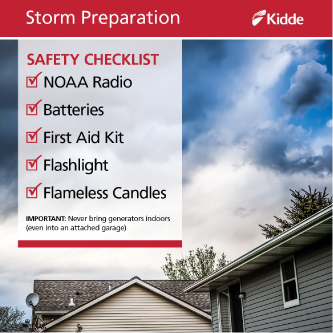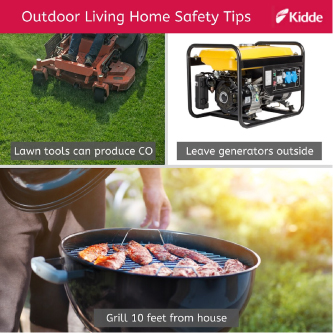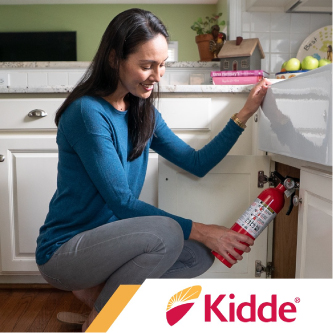Tips to prevent carbon monoxide poisoning before, during and after storms

Storm-related power outages can significantly increase the chance of a house fire or carbon monoxide (CO) poisoning. Items like generators, candles, and downed-power lines all pose a risk. The Consumer Product Safety Commission (CPSC) says deaths involving portable generators have been on the rise since 1999 when they became widely available to consumers. The majority of these occur as a result of using a generator inside a home or attached garage. Ensuring that your home has working battery-operated CO and smoke alarms as well as fire extinguishers before a storm strikes, and taking safety steps during a storm's aftermath could literally mean the difference between life and death.
The experts at Kidde recommend the following safety tips:
AFTER the Storm Safety:
- DO NOT plug space heaters into an extension cord
- DO extinguish all traditional candles
- Place pump and power unit of high-pressure washers outside and away from air intakes to the home to prevent CO fumes from seeping inside.
How to prepare for the next storm:
BEFORE a Storm Strikes:
- Add at least one battery-operated, smoke alarm or CO alarm in all sleeping areas.
- Purchase battery-powered alarms with a 10-year sealed-in lithium battery
- Test the batteries in your hardwired smoke alarms and replace them if necessary.
- Keep a multi-purpose fire extinguisher, within reach in rooms where fires are most likely to start.
- If you have an extinguisher, check the gauge to ensure it's charged. Green = go; Red = replace.
- Ensure that fuel-burning appliances are properly installed and working according to the manufacturer's instructions.
- Ensure that fireplaces - wood-burning and gas logs - are properly maintained.
- Prepare a storm safety kit with necessary supplies. Visit ready.gov for more information
DURING the Storm Safety
Tips for Candles:
- Consider flameless candles. Don't use traditional wick candles.
- Keep traditional candles at least 12" from anything flammable. Extinguish all candles when leaving a room or the house, or when going to sleep.
- Use battery-powered flashlights or lamps for light whenever possible.
- Grill outdoors: Place your grill at least 10' from the home and make sure it is clear of any vents that could carry any CO into the home.
Tips for Grilling Indoors:
- DO NOT grill or cook in an enclosed or attached garage, even with the door open!
- DO NOT Use ovens to heat your home.
- DO NOT Use gasoline in place of kerosene. Keep combustible liquids away from heat sources and locked away from children.
These activities can emit CO, even with the door open enough oxygen may not enter to clear out any CO that may be in the environment.
Tips for Generators:
- Place generator outdoors - Install your generator outdoors at least 15' from the home with the exhaust pointing AWAY from the house.
- DO NOT use in home and/or in an attached garage, porches, or patios. Generators can emit as much Carbon Monoxide as 100 idling cars so this is very dangerous.
- Only operate the generator outdoors in a well-ventilated, dry area, away from air intakes to the home and protected from direct exposure to rain.
- Use the appropriately sized and type power cords and never run them under rugs or carpets. Overloaded or covered cords could overheat and cause fires.
Tips for Cars:
- Move running/idling cars away from the home.
- When idling or running gasoline-powered automobiles, move them out of attached garages/porches
- DO NOT run your car in an attached garage even if the garage door is open! Gasoline-powered cars can emit CO, even with the door open enough oxygen may not enter to clear out any CO that may be in the environment. Instead, pull your car away from the home at least 20' to ensure enough clearance.
Tips for Firewood:
- Do not burn anything in your fireplace or fire pit indoors that is not specifically designated as firewood.
- Check Flues and ducts: Ensure that storm debris hasn't blocked or sealed shut exhaust flues or ducts for appliances such as chimneys, water heaters, ranges, and clothes dryers, or blocked your vehicle's tailpipe, which could cause CO fumes to build up inside the vehicle.
- Use a fire extinguisher to put out a small, self-contained fire when there is a clear exit behind you, or to create a pathway to safety when all exits or escape routes are blocked. Always call the fire department before you try and extinguish a fire yourself. Respect all fires, regardless of size. The main objective is safe escape.
- If you suspect CO is present in the home, get to fresh air immediately and call 911.
- DO NOT Burn anything in your fireplace or fire pit indoors that is not specifically designated as firewood. This includes furniture or other items as they may have coatings that can create toxic smoke or burn more rapidly than firewood.
DO NOT BE A HERO.
If you cannot extinguish a fire quickly, get outside and dial 911.






